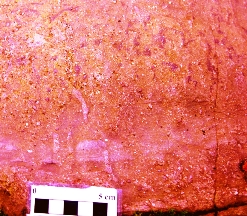
Desiccation cracks are rarely observed, as are vertisol calcretes typical of the post-Ludlow ORS succession. The majority of primary sedimentary structures appear to have been overprinted by bioturbation and pedoturbation fabrics. The former comprise unlined Skolithos burrows commonly in spectacular “pipe rock” colonies. Variations in oxidation/reduction of iron is common, with reduction mottling indicative of variations in primary water table position. Prolonged evidence of elevated water table development is given by more extensive, sheet-like gleyed intervals. Reduction mottling (pseudo-gleying) around burrow margins is well developed as are spectacular ferricrete soil profiles indicated by nodular and laminar alternations of purple to grey iron oxide. The ferricretes and gleyed horizons provide evidence of sustained, elevated water table height (a wetland environment) unlike the majority of ORS soils in the region that demonstrate development in dryland (warm with seasonal rainfall) conditions.
It seems likely that this prolonged elevated water-table provided conditions opportune to the colonisation by the Skolithos-generating organism(s). While Skolithos has been traditionally associated with shallow-marine environments, it is now generally accepted as a trace produced in a myriad of environments with shifting, high energy substrates from terrestrial lakes through to deep-marine environments. The lack of shelly faunas from the formation, other than some lingulid and orbiculoidean brachiopods from a well-defined grey mudstone interval, supports a terrestrial environment.
The leaders suggested that the Trichrug Formation developed as a shallow water wetland, possibly similar to that of the present Okovango Delta in Botswana. Here, across the surface of the internally-draining delta, shallow ponds are sustained throughout the year by a mixture of groundwater recharge and seasonal rainfall-related discharge. No deep water lacustrine conditions analogous to those of other ORS lakes (e.g. the Orcadian Basin) are postulated, due to the observed lack of fine-grained facies.
In the Cennen road section, a thinner, but more proximal development of the Trichrug Formation contains thick beds of coarse, ill sorted, muddy exotic clast conglomerates interbedded with poorly sorted sandstones and ferricrete palaeosol profiles. The leaders argued that this association developed on debris-flow dominated alluvial fans shed off contemporaneous fault scarps located along the southern margin of the Welsh Basin and which interfingered with the shallow water wetland facies.
On the second day the trip visted the classic Ludlow section at Cwm Graig ddu near Builth Wells, some 40 km to the NE. Here, in contemporaneous distal shelf/ proximal ramp mudstones, there is surprisingly no obvious evidence of the lowstand event represented by the Trichrug Formation to the SW.
¨British Geological Survey, Cardiff; * Geology Department, National Museum of Wales, Cardiff